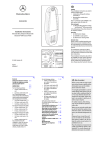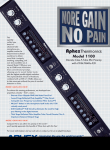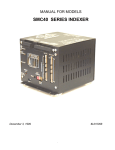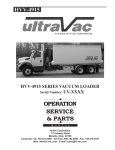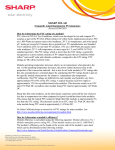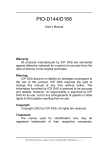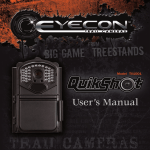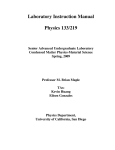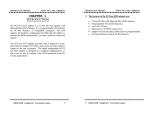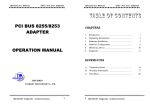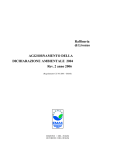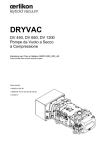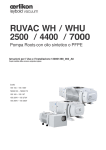Download General System Usage - Oregon State University
Transcript
Hai Chiang, Chris Tasker, and Rick Presley Sputtering Utility Program (SUP) User’s Manual – v1.5 April 22, 2005 General System Usage 1.0 • • • • • • 1.1 • • General Info and Precautions There is no interlock that prevents the z-translator from moving into an extended sputter gun, it is the responsibility of the operator to ensure that this does NOT happen. When loading or removing a substrate, take care not to scratch the sealing surfaces on the load lock. The deposition angle should only be varied 60° (in either direction) from the vertical position. There are two vertical positions, 0 and 180°. Adjustment of the angle of incidence should go in the positive direction, i.e. 0 to 180° rather than 360 to 180°. Vacuum gauge setup Location Setpoint Load Lock (TC1) 3 1 mTorr Foreline (TC2) 2 100 mTorr Chamber (Capacitance Manometer) 1 100 mTorr After using the system, it should be left in the following state: 1. Guns/shutter retracted. 2. Z-translator extended. 3. 1” Translator extended 4. Load lock isolation valve closed. 5. Turbo isolation valve open. 6. Rough valve closed. System Startup System startup can vary depending on the state the system is found. Assuming that the system is found at atmosphere and all valves/relays are closed, the following startup procedure would hold. Administrative access is required to startup the system. Contact the system administrator, Chris Tasker ([email protected]), for assistance. 1. System verification Verify that the control system (DIO input/output board, vacuum gauge controllers, etc.) is powered. Check that the RS-232 cable for the stepper motor controller is plugged into the back of the PC. Leaving the RS-232 unplugged can cause the control program to stall or react extremely slowly. 2. In the control program, enter the “System Startup/Shutdown” area. A login prompt will appear when the button is clicked. 3. Turn on the chillers and dry mechanical pumps by performing the following tasks: Energize the 120 V coolant relays by clicking the “Coolant Relay” button. The color of this button should change from red to green. Open the cooling water supply/return valves. Provide 120V to the backing and load lock pumps by clicking on the “Backing Pump” and “Load Lock Pump” buttons. Page 1 of 18 4. 5. 6. 7. 8. 9. 10. 11. The chillers and dry mechanical pumps are located in the storage closet. Turn on the chillers. In the current setup, there are 2 chillers, one supplying cooling water to the system and the other supplying cooling water to the dry mechanical pumps. The load lock pump has an additional RuVac in series. First, turn on the load lock pump (which is the left control box), wait ~30 seconds, and then turn on the RuVac. Turn on the backing pump. Before opening the foreline, complete the following tasks: Verify that the Turbo Pump blades are not spinning by placing your hand on top of the pump. Verify that the regulator supplying nitrogen to the leak/vent valve of the turbo pump is set to 0.5 Bar. If the blades are not spinning, vent the turbo pump. Venting the pump will provide positive pressure, preventing backflow from the backing pump once the foreline is open. If the blades are still spinning, wait until they stop (if the pump is isolated, it can take several hours for the blades to spin down from full rpm, which is 38k for this particular pump.) before venting the pump. Open the foreline valve. Wait for the foreline interlock to engage before proceeding any further; the interlock will engage approximately 30 seconds after the valve is opened. This wait will give sufficient time for the foreline pressure to fall below the setpoint, which is currently set at 100 mTorr. To rough the chamber, complete the following steps: Verify that the chamber pressure (cap man) and load lock pressure are in the same relative state. The VAT valves that are used for load lock and turbo pump isolation have a maximum differential pressure that can be present when opening and closing the valve. (1 bar when closing) Open the load lock isolation valve. Open the roughing valve. Allow the chamber to rough to 50 mTorr. To check the chamber pressure, hit the “CHAN” button on the Multigauge Controller until you reach the capacitance manometer (a flashing “1” will appear towards the lower right). Close the load lock isolation valve, then roughing valve. Throttle the turbo isolation valve and check the foreline pressure. Allow the foreline pressure to stabilize below 5 mTorr and then open the turbo isolation valve. Start the turbo molecular pump. This is done by: Closing the turbo pump “interlock” switch then the “start” switch. The blades should start to spin; the turbo controller display should say “Soft Startup”. Soft startup slowly increases the rotational speed of the blades; it will take approximately 40 minutes to reach full rpm. After several minutes, it should be it should be safe to turn on the BA Ionization gauge. To do this, hit the “CHAN” button on the Multigauge Controller until the BA Ion Gauge channel is showing, then hit the “EMIS” button. Calibrate the z-translator Click on “Calibrate Z-Translator”. Ensure that nothing the guns/shutter are fully retracted. First, look in the chamber with a flashlight. Retract the guns if needed. Slightly extend the shutter, then retract it. Do this on both sides of the chamber. This verifies that the shaft has not “detached” from the magnetic coupler. Click on “Extend Z-Translator”. Allow the z-translator to move to the end of its stroke, i.e. allow the z-translator to extend until it hits the limit switch. Reset the stepper controller. Click on “Retract Z-Translator”; this should move the z-translator to the load position. Extend the 1” translator Page 2 of 18 12. Enter applicable comments and then click the “OK” button. This will exit the Startup/Shutdown area, and return the program to the main page. 13. Allow the system to pump down to base pressure, ~1E-7. Page 3 of 18 1.2 Sputter a Film 1.2.1 Log User/Sample Information 1. Input the required information Choose a Sample ID; this can be anything that you choose. Choose the deposition gun/material: o Gun numbering system: Stand at the end of the system, facing the load lock. Guns L-1 and L-2 are located on the left hand side (L-1 is the gun on the left flange that is closer to the turbo pump). Guns R-1 and R-2 are located on the right hand side. Currently Guns L-2 and R2 are not installed 2. Move onto the next page by clicking “Continue”. 1.2.2 Load Substrate 1. Before proceeding, verify that the guns/shutters are fully retracted as described in section 1.1.10. 2. Log the system base pressure. 3. Turn off the ionization gauge; the gauge uses a tungsten filament and should be allowed to cool for approximately 5 minutes. 4. Set your processing temperature. The temperature may overshoot and need several minutes (to half an hour) to stabilize. 5. Load substrate(s) by completing the following: Vent the load lock. Retrieve the substrate holder and mount your substrate(s). Load the substrate holder. When loading or removing a substrate, take care not to scratch the sealing surfaces. Secure the load lock door by LIGHTLY tightening screw knob; once the rough valve is open, the door should close tightly and make a good seal, so there is no need to overtighten the door knob. Rough the load lock to 1 mTorr. 6. Close the turbo isolation valve and flow an inert gas to bring the chamber to 10 mTorr. To flow a gas, open the MFC shutoff valve, then flip the appropriate channel to “On”. Depending on the programmed flow rate, the pressure may rise rapidly, so be ready to close the shutoff valve. Close the shutoff valve, then turn gas flow off. 7. Transfer substrate(s) from the load lock to the deposition chamber by completing the following: Open load lock isolation valve. Set the shim in place and extend the load lock translator. The shim will provide the clearance needed to successfully retract the z-translator. Retract 1” translator Remove the shim Fully extend the load lock translator. Look in the chamber to verify that there is spacing between the substrate holder and the load lock translator. Additionally, verify that there is sufficient spacing between the heater and the load lock translator. Move the z-translator to “pre-load” position Wait for the z-translator to stop moving. Look in the chamber to verify that the load lock translator can clear the substrate holder, then retract the load-lock translator. 8. Close load lock isolation valve 9. Close the rough valve Page 4 of 18 10. Throttle the turbo isolation valve until the capacitance manometer is out of range (it will display “---“. Then, fully open the turbo isolation valve. 11. Retract the z-translator. If you did not verify that the guns/shutters are fully retracted, do so before retracting. 12. Once the z-translator has stopped moving, set angle of incidence (±60° from vertical). 13. Wait until the system has reached base pressure, then hit “Continue”. Note: The control program will check that the load lock isolation valve must be closed, the ztranslator must be retracted, and the 1” translator must be retracted before allowing you to continue. 1.2.3 Strike Plasma/Program Stepper 1. Determine a valid throw distance and angle of incidence. Throw distance is the distance from the face of the gun to the center of the chamber. The graph located in the Appendix shows minimum throw distance as a function of theta. Diagram of substrate assembly: Theta Claw Heater 1.5” ¢ Substrate Holder 1” 3.8125” (Not to scale) Theta can be adjusted ±60° from the vertical position (note that the vertical position is shown in the diagram). If either gun L-1 or L2 is being used, theta can be adjusted from 60° to 0° and 0° to 300° (0° is vertical). If gun R-1 is being used, theta can be adjusted from 120° to 240° (180° is vertical). Verify that the throw distance and the angle of incidence, set earlier, are valid. 2. Extend the shutter, then the gun that will be used for this deposition. 3. To strike a plasma, complete the following: Verify that the gun cooling water is flowing. Verify that the rf cable is connected to the correct gun. Throttle the turbo isolation valve. Open the shutoff valves for the MFC’s which will be used. Adjust the flow setpoints if needed. Page 5 of 18 4. 5. 6. 7. 8. 9. Turn “On” the appropriate channels. ALWAYS flow the least reactive gas first. Adjust the throttle valve to the appropriate processing pressure. Set the striking power. Then turn “On” the rf power. Note: Many of the targets used in the lab are ceramics. Thus, the recommended striking powers are 40 and 80 W for the 2 and 3 inch guns, respectively. Once the plasma is ignited, monitor the dc bias and plasma characteristics. Allow the dc bias to stabilize, then increase the power to your sputtering power at a rate of 5 and 10 W/min for the 2 and 3 inch guns, respectively. Slowing increasing the power on ceramic targets minimizes the possibility of cracking the target. If the target is new, it requires a “burn-in” run. This can range anywhere from 6 to 12 hours depending on where the target was obtained. Targets that are fabricated “in-house” typically require longer burn-in times. Allow the target to presputter. When presputtering, place the shutter should be placed in front of the target; this will help keep the sputter chamber clean. Log your sputter parameters while your target is presputtering. Program stepper controller. Note that the scale has been reversed, fully extended is 0”, not 30” as the ztranslator ruler says. Thus, when “retracting”, the position is increasing. Rotate the shutter and move it out of the way. Move your substrate into place. Hit the “Continue” button once sputtering is complete. 1.2.4 Retrieve Substrate 1. Extinguish the plasma by completing the following: Retract the z-translator Move the shutter back in front of the gone. Slowly decrease the RF input power to the recommended striking power if you are using a ceramic target. Unless you are sputtering at the recommended striking powers, NEVER turn off the power without allowing it to cool down. Use the same rates for increasing/decreasing rf power. Turn off the rf power. Retract the sputter gun and shutter. 2. Turn off heater. 3. Remove your substrate(s) by completing the following: Set angle of incidence back to 0. Look in the chamber to ensure there are no obstructions. Extend the z-translator to the “pre-load” position. Close the turbo isolation valve and leak up to 10 mTorr. Rough the load lock. Open load lock isolation valve. Extend Load lock translator; the shim should not be used this time. If the load lock translator hits the substrate holder, the angle of incidence may need to be adjusted by a few degrees for proper unloading. Once the load lock translator is in place, extend the z-translator. Extend 1” translator once the z-translator has stopped moving. Retract load lock translator 4. Close load lock isolation valve 5. Close the rough valve. 6. Throttle the turbo isolation valve, then fully open it. 7. Allow the substrate to cool in the load lock 8. Retrieve substrate Loosen the door knob on the load lock. Page 6 of 18 Vent the load lock. Retrieve substrate. Caution: Do not scratch the sealing surface of the load lock. Additionally, if you used substrate heat, you may want to use insulated gloves! 9. Return the substrate holder to the load lock. 10. Rough the load lock (close the rough valve once the load lock is below 1 mTorr). 1.3 Changing Targets 1. Bring the chamber and load lock to the same state. 2. Close Turbo Iso valve. Note, the isolation valve will automatically throttle itself, wait, and then fully close. 3. Open Load Lock Iso 4. Vent chamber Remember to loosen the doorknob before venting. Close the vent valve once the chamber has reached atmospheric pressure. 5. Change the target Remove all but two bolts on the appropriate 6” conflat flange. Dismount the flange from the chamber. Hold the base of the gun (near the flange), and move the flange in an up/down motion until the seal with the gasket breaks. Note: Do NOT hold the shaft of the gun. Remove the old target and mount the new one. o Currently, only US Mighty Mak guns are used on this system. o Make sure that there is a thin layer of thermal compound on the cathode. o There are no screws needed; the magnet/keeper will hold the target in place. Remove and discard the used gasket. Gaskets are NEVER to be reused. Clean the knife edge on the 6” flange and the chamber with a Kimwipe and some methanol. Obtain a new gasket and visually inspect the gasket for defects and cleanliness. Blow the gasket off with nitrogen. Mounting the flange. First, place the copper gasket on the 6” flange. Ensure that it is seated properly, then slowly move the flange towards the chamber. Remember, all knife edges are sealing surfaces!! Once the flange is seated on the chamber, line up the leak check grooves. Hold the flange there and install four bolts finger-tight. You can then let the flange loose and finish installing all the bolts. Finally, torque the flange. A 6” flange is tighten to 16 ft-lb. 6. Open Rough Valve and allow the system to pump below 50 mTorr. 7. Close Load Lock Iso Valve (the rough valve should automatically close) 8. Throttle Turbo Iso Valve and allow the foreline to stabilize. 9. Open Turbo Iso Valve 1.4 Changing Gas Cylinders 1. Log any gas changes and update the labeling on the MFC box appropriately. Page 7 of 18 Application Notes 2.0 DIO Card Steps for programming (for PCI-7248 pgs. 36-40, 49-59, 66-71, 74) o Initialize the card o Register_Card(PCI_7248, 0) o Setup the ports. DIO_PortConfig(card, i * 5 + Channel_P1A, OUTPUT_PORT) DO_WritePort(card, i * 5 + Channel_P1A, &HFF) Port Info Port Signal P1A0 P1A1 P1A2 P1A3 P1A4 P1A5 P1A6 P1A7 P1B0 P1B1 P1B2 P1B3 P1B4 P1B5 P1B6 P1B7 P1C0 P1C1 P1C2 P1C3 P1C4 P1C5 P1C6 P1C7 Coolant Temp Coolant Flow Leak (Water) Comp Air Turbo Fault Signal Backing temp warn Cap. Man. Foreline TC Ld Lk TC Idle State Port Signal 1 1 1 1 0 1 1, & 1, & 1 P2A0 P2A1 P2A2 P2A3 P2A4 P2A5 P2A6 P2A7 P2B0 P2B1 P2B2 P2B3 P2B4 P2B5 P2B6 P2B7 P2C0 P2C1 P2C2 P2C3 P2C4 P2C5 P2C6 P2C7 Turbo System Override + Generator Interlock 1” Extend/retract relay Ld Lk Valve Relay A Ld Lk Valve Relay B Turbo Valve Relay A Turbo Valve Relay B Coolant Relay A Coolant Relay B Ld Lk Vent Relay MFC DCV Power Foreline Valve Backing Pump Load Lock Pump Ld Lk Trans Top of Stroke Ld Lk Iso Valve Closed Gun Retracted Shutter Retracted Critical OR Gate Backing Oil Pressure Backing Temp Alarm Backing Motor Temp Load Temp Warn Load Oil Pressure Load Temp Alarm Load Motor Temp 1 1 1 1 1 1, & 1 1 1 1, & 1 1 Legend: In/Out/Critical Signals * Interlocked signal + Damaged Output Port & Special Startup/Shutdown Considerations Code Additional Signals P3A0 P3A1 P3A2 P3A2 P4A0 P4A1 Z extended Z retracted Extend Limit Switch Retract Limit Switch Extend Z translator Retract Z translator Motor Motor Motor Motor Motor Motor Commands DI_ReadLine DI_ReadPort DIO_PortConfig DO_ReadLine DO_ReadPort DO_WriteLine DO_WritePort Register_card Release_card Page 8 of 18 *, P1B4, P2C0 *, P1A7, P2B5 Turbo low speed Turbo interlock Interlocks *, P1B5, P1B6, P1A6 *, P1B5, P1B6, P1A6 *Newly added signal **Default is the state that the system is “normally” in (already started up) Useful o o o o o o o o o *, P3A0, P3A1 *, P1B0, P1B3 *, P1B0, P1B3 *, P1A6, P1A7, P1B4, P2B5 *, P1A6, P1A7, P1B4, P2B5 Rough Valve Leak Valve Turbo Start Source Stepper Stepper Stepper Stepper Stepper Stepper Interlock 2.1 Vendor Contacts and Application Specific Information 2.1.1 Dry Vac/ RuVac 1. Leybold DryVac 50B Company Info: LEYBOLD VACUUM USA INC. 5700 Mellon Road Export, PA 15632 http:// www.leyboldvacuum.com/ Contact(s): Name: Ken Arondt Phone: (724) 327-5700 x551 Email: N/A 120 VAC supplied from the DIO system is required to start the pumps. DB-9 Connecter Pin 1 2 3 4 5 6 7 8 9 Signal Gnd Motor Temp 24 V Temp Alarm Oil Pressure Temp Warning 8-wire Conductor Drain Black Brown Red Orange Yellow DIO Signals o DIO Inputs (Backing and Load Lock Pumps) Temperature Warning Oil Pressure Temperature Alarm Motor Temp If all signals are ‘1’, then the pump is operating normally. o DIO Outputs Backing Pump (120 VAC supply) Load Lock Pump (120 VAC supply) 2. Leybold RuVac The cooling fan operates on a separate motor and spins in the opposite direction of the pump motor. The arrow indicates the direction of the pump motor. 2.1.2 RF Power Supply 1. ENI OEM-25A 2500W RF Power Supply Company Info: ENI Products 100 Highpower Road, Rochester, NY 01887 http://www.enipower.com/ Page 9 of 18 Contact(s): Name: Vitaly Phone: (585) 427-8300 Email: N/A Name: Billy (Technician) Phone: (585) 214-0316 Email: N/A Name: Debbie Thibault (Sales) Phone: (585) 292-7478 Email: [email protected] 2. ENI MW-25D RF Matching Network 2.1.3 Sputter Guns (US Inc. Mighty Mak L200A01L/L300A01L) Company Info: Us Inc. 6280 San Ignacio Ave. Suite E San Jose, CA 95119-1365 http://www.us-incorp.com Contact(s): Name: Todd Johnson Phone: (408) 363-6909 Fax: (408) 363-6996 Email: 2.1.4 Turbo Molecular Pump (Varian TV1001 Navigator) Company Info: Varian Electronics Manufacturing - Rocklin 3715 Atherton Road Rocklin, California 95765 http://www.varianinc.com Contact(s): N/A 100 mTorr cross-over pressure. Since the dry-vac/roots blower stack pumps so quickly, we will use 1E-4 as the crossover pressure. 10 sccm nitrogen leak used to keep particulates and corrosive materials away from the bearings of the turbo pump. Turbo Pump Female DB-9 (Input) Pin Signal 8-wire 2-wire Conductor conductor 1 Start Black 2 Low Speed Brown 3 Interlock Red 4 Turbo Black Override 5 6 Start (Com) Orange 7 Low Speed Yellow (Com) 8 Interlock Green (Com) Page 10 of 18 9 Turbo Override (Com) White Turbo Pump DB-15 (Output) Pin Signal 1 2 3 4 5 6 7 8 Fault 9 10 11 12 13 14 15 Fault (+24 V) 2-wire Conductor White Black DIO Signals o DIO Inputs Turbo Fault Signal (1 = fault present, 0 = no fault) o DIO Outputs Turbo System Override (1 = turbo pump overridden) 2.1.5 Vacuum Chamber (Nor-Cal) Company Info: Nor-cal Products http://www.n-c.com Contact(s): Name: Steve Greuel (Products Manager), Monica (Sales) Phone: (530) 842-9130 Fax: (530) 842-4457 Email: [email protected] 2.1.6 Z-translator 1. Z-translator Unit (McAllister Technical Services) Company Info: McAllister Technical Services West 280 Prairie Avenue Coeur d' Alene, ID 83815 http://www.mcallister.com/ Contact(s): Name: Bob McAllister Phone: 1-800-445-3688 Fax: (208) 772-3384 Email: [email protected] Page 11 of 18 Z Translator (ZA-450-30) o The brass drive-gear attached to the lead screw has 20 teeth, while the worm gear has 4 starts. This equates to a gear ratio of 5:1 between the motor shaft and lead screw. o The z-translator travels .1 inches per revolution of the lead screw. Rotary Platform (DPRF-450) Divide-by-10 Z-positions Gun L1 Start Gun L1 Finish Gun R1 Start Gun R2 Finish Retract Load position Position (inches) 23.65” 11.65” 20.325” 8.625” 29” .6875 (11/16)” Position (Steps) 2,490,000 1,227,500 2,175,000 906,250 68,750 2. Stepper Motor/Driver (Anaheim Automation) Company Info: Anaheim Automation 910. East Orangefair Lane, Anaheim, CA, 92801-1195 http://www.anaheimautomation.com/ Contact(s): Name: Alfonso Esparza (Applications) Phone: 1-800-345-9401 Email: [email protected] Stepper Motor (23D309S) o The motor is rated at 2.2 V, 4.6A per phase. o Stepper Motor Wires Color Red Red – White Green Green - White Signal Phase A+ Phase A Phase B+ Phase B - Driver/Indexer (DPD60401) o The driver in this package is a 1-5.5A driver with micro-stepping capabilities. o The maximum speed of the motor shaft at full torque is 10 revs/sec; this equates to .2 inches/sec (5 secs/inch). o The minimum speed without missing steps is 5000 steps/rev (divide-by-25). At 1 step/sec, it would take 4167 minutes to traverse 1 inch. o Limit Switch Wires Color Orange Red Yellow Green o Signal Limit SW 1 Limit SW 1 Return Limit SW 2 Limit SW 2 Return DIO Signals a. DIO Inputs Z-extended Z-retracted Page 12 of 18 Extend Limit Switch (1 = Switch Engaged) Retract Limit Switch (1 = Switch Engaged) b. DIO Outputs Extend Z-translator Retract Z-translator 2.1.7 Miscellaneous 2.1.7.1 GRI 2800 Water Sensors Company Info: George Risk Industries GRI Plaza 802 S Elm St Kimball, NE 69145 http://www.grisk.com/ Contact(s): Name: N/A Phone: 1- 800-523-1227 Email: N/A Purchased through Platt in Corvallis @ 8.42 per unit. (541) 753-1221. DIO Input: Leak (1 = Leak Present) 2.1.7.2 Heater Company Info: Solar Products 228 Wanaque Avenue Pompton Lakes, N.J. http://www.solarproducts.com/ Contact(s): Name: John Schafer Phone: (973) 248-9370 Fax: (973) 835-7856 Email: [email protected] Specifications: o 110 V o 60 W/ Sq. Inch o 7” x 7” Face o 2.25” Thick o High Purity quartz Coil direction is critical; coils run parallel to the main chamber axis. 2.1.7.3 MDC 1-inch Translator Company Info: MDC 23842 Cabot Blvd. Hayward CA 94545-1661 http://www.mdc-vacuum.com/ Contact(s): Name: N/A Phone: 1-510-265-3000 Page 13 of 18 Email: N/A 2.1.7.4 MKS Baratron Capacitance Manometer Company Info: MKS, Pressure Measurement & Control Products Six Shattuck Road Andover, Massachusetts 01810 United States http://www.mksinst.com/ Contact(s): Name: N/A Phone: 1-800-227-8766 Fax: (978) 975-0093 Email: N/A 2.1.7.5 Thermionics Rotary Linear Feedthroughs Company Info: Thermionics Vacuum Products 231-B Otto Street Port Townsend, WA 98368 http://www.thermionics.com/index.shtml Contact(s): Name: Tom Howard Phone: 1- 800-962-2310 Fax: (360) 385-6617 Email: [email protected] 2.1.7.6 Varian Multi-gauge Controller Company Info: Varian Electronics Manufacturing - Rocklin 3715 Atherton Road Rocklin, California 95765 http://www.varianinc.com Contact(s): Name: N/A Phone: N/A Email: N/A The original manual sent with the Multi-Gauge was not correct, it did not have correct datasheet for the set point board installed in the Multi-Gauge (L8727302). Set Point DB25 o SP1 – Cap Man o SP2 – Foreline TC o SP3 – Load Lock TC Pin 1 2 3 Signal 8-wire Conductor Page 14 of 18 4 5 6 7 8 9 10 11 12 13 14 15 16 17 18 19 20 21 22 23 24 25 SP3-NO SP3-C SP2-C Violet Yellow Red SP1-C Black SP2-NO Orange SP1-NO Brown DIO Inputs o Cap. Man (1 = Pressure below set point of 1E-1) o Foreline TC (1 = Pressure below set point of 1E-1) o Load Lock TC (1 = Pressure below set point of 1E-3) 2.1.7.7 VAT Valves Company Info: Thermionics Vacuum Products 231-B Otto Street Port Townsend, WA 98368 http://www.thermionics.com/index.shtml Contact(s): Name: Tom Howard Phone: 1- 800-962-2310 Fax: (360) 385-6617 Email: [email protected] 70-80 psi is required to open/close the valve. DIO Signals o DIO Inputs Load Lock Iso Closed (1 = Valve Closed) o DIO Ouputs Ld Lk Valve Relay A/B (Closed A=0, B=0; Intermediate Open A= 1, B=1) Turbo Valve Relay A/B (Closed A=0, B=0; Intermediate Open A= 1, B=1) Page 15 of 18 A=1, B=0; A=1, B=0; General System Usage 3.0 Chamber Dimensions referenced to the Z-translator Load Lock Turbo Pump ¢ ¢ L-1 L-2 3.015” 12” 14” 8” 6” 7” Z-Position 17 3/8” 11 3/8” 3/8” Note: The numbers referenced above are referenced relative to the “physical” position of the ztranslator. There is an addition 3/16” offset required get the position of the center of the wafer; 11 9/16” for L-2 and 17 9/16” for L-1. 3.1 Maximum Throw Distance ¢ Gun L-1 Gun R-1 Max Throw Distance = 8.215” Max Throw Distance = 7.775” 3.91” 4.35” 11” + 1.125” 11” + 1.125” Page 16 of 18 3.2 Throw Distance vs. Theta 3.2.1 Guns Installed on Left Flange Min Throw Distance vs. Theta 4.5 4 Min. Throw Distance 3.5 3 2.5 2 1.5 1 0.5 0 0 10 20 30 40 50 Theta (Degrees) 3.2.2 Guns Installed on Right Flange Page 17 of 18 60 70 80 90 Min. Throw Distance vs. Theta 4.5 Min. Throw Distance (Inches) 4 3.5 3 2.5 2 1.5 1 0.5 0 90 100 110 120 130 140 Theta (Degrees) Page 18 of 18 150 160 170 180



















